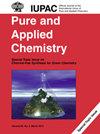Positional microstates and probability fields in real systems
IF 2
4区 化学
Q3 CHEMISTRY, MULTIDISCIPLINARY
引用次数: 0
Abstract
A previously published paper provided six examples of spontaneous processes for ideal systems that cannot be explained using classical thermodynamics. These six examples include free expansion of an ideal gas, mixing of ideal gases, diffusion of an ideal solute, mixing of ideal solutes, osmosis with ideal solutions, and free discharge of a concentration battery with ideal solutions. The previous paper demonstrated how energy was not a driving force in any of these examples and then proceeded to develop a positional entropy model,真实系统中的位置微态和概率场
之前发表的一篇论文提供了六个无法用经典热力学解释的理想系统自发过程的例子。这六个例子包括:理想气体的自由膨胀、理想气体的混合、理想溶质的扩散、理想溶质的混合、理想溶液的渗透以及理想溶液浓度电池的自由放电。上一篇论文证明了能量在这些例子中都不是驱动力,并进而建立了一个位置熵模型 S D,解释了这些自发过程发生的原因。这篇新论文为同样的六个系统提供了计算位置熵 S D 的方法,但针对的是实际粒子,包括非零体积粒子、不同体积粒子以及粒子间相互作用不同的粒子。这项工作的重要成果表明,无论是理想粒子还是真实粒子,这六个示例系统的自发放电都是由微观状态的非平衡分布所产生的概率场造成的。概率场会使粒子向平衡分布偏移,偏移是概率增加的结果,而不是能量减少的原因。这项工作的另一个结论表明,概率场对位置微态最终平衡分布的放电消除了系统中的势能,但并不违反能量守恒定律。
本文章由计算机程序翻译,如有差异,请以英文原文为准。
求助全文
约1分钟内获得全文
求助全文
来源期刊

Pure and Applied Chemistry
化学-化学综合
CiteScore
4.00
自引率
0.00%
发文量
60
审稿时长
3-8 weeks
期刊介绍:
Pure and Applied Chemistry is the official monthly Journal of IUPAC, with responsibility for publishing works arising from those international scientific events and projects that are sponsored and undertaken by the Union. The policy is to publish highly topical and credible works at the forefront of all aspects of pure and applied chemistry, and the attendant goal is to promote widespread acceptance of the Journal as an authoritative and indispensable holding in academic and institutional libraries.
 求助内容:
求助内容: 应助结果提醒方式:
应助结果提醒方式:


